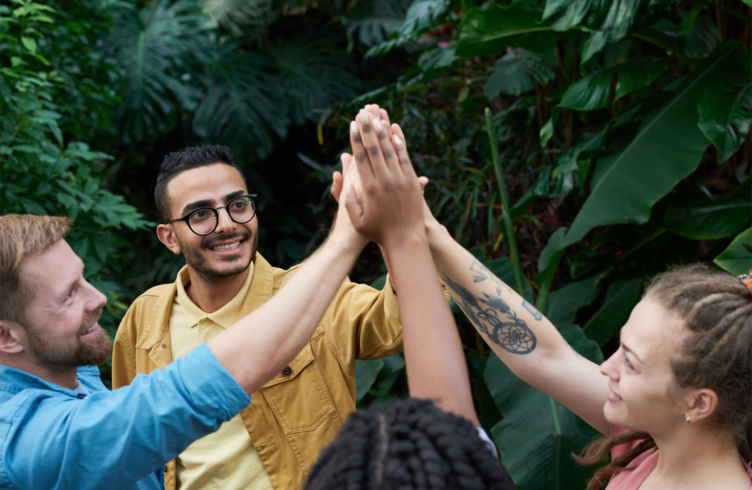The Power Of Cooperation
“Alone we can do so little; together we can do so much.” — Helen Keller.
Have you ever pondered over the beauty of a mountain range, a testament to millions of years of environmental cooperation? Or have you been fascinated by the synchronized dance of a bee colony due to their communal effort? These wonders of nature and human ingenuity underscore a fundamental truth: our greatest human achievements, from conquering diseases to exploring space, have been possible because of our ability to collaborate. But as we confront urgent global issues like climate change and pandemics, the question emerges: can we leverage the power of cooperation to create a better future for all? This article delves into the impact of collaboration, navigates the obstacles that impede it, and issues a persuasive call to action, reminding us that “United We Stand” is not just a saying but the foundation for a prosperous future.
People working together can effect positive change in the world through collective action. For example, consider how the abolition of slavery through international efforts marked a turning point in humanity’s history. The 1815 Declaration heralded the first global agreement denouncing the slave trade. Then, in the 19th Century, pressure from Britain, a dominant naval power, helped curb slave ships. In 1920, The League of Nations urged its member states to eradicate slavery within their territories. Moreover, the United Nations Universal Declaration of Human Rights (1948) proclaimed slavery a violation of human rights, a testament to the global impact of cooperation.
Similarly, developing life-saving vaccines through global collaboration has led to innovative solutions to global health crises. With countries’ cooperation, we witnessed the first RNA vaccines to combat the Coronavirus. Also, the construction of large-scale infrastructure projects that necessitate international cooperation is a testament to the strength of unity and collaboration. Consider the International Space Station, a product of the combined efforts of countries including the United States, Russia, Canada, Japan, & the European Space Agency. Cooperation is abundantly evident in symbiotic relationships within ecosystems. This is clear in pack hunting strategies for animals. Despite hierarchical structures within the animal kingdom, there is a unified cooperative system so all members of the pack benefit from the hunt. This is evident in mammals, birds, and even marine mammals. Equally, this cooperation is found in insect colonies, such as ants and bees, which work towards a common goal, so each insect benefits from the collaborative effort of the entire colony, a reassuring testament to the natural occurrence of cooperation.
The Challenges Of Cooperation
“The only thing that will redeem mankind is cooperation.” — Thomas Carlyle.
This brings us to the Prisoner’s Dilemma, a fundamental concept in game theory that illustrates why two individuals may choose not to cooperate, even though it is in their best interest to do so. The dilemma is illustrated by the following example: Two criminals are caught and interrogated separately. They have two choices: betray each other or remain silent.
- If one prisoner betrays and the other stays silent, the traitor goes free, and the silent one receives a heavy sentence (10 years).
- They get a modest sentence if both betray each other (5 years).
- If both remain silent, they get a light sentence (1 year).
The dilemma is that although cooperation (both staying silent) produces the best result (1-year sentence each), the fear of being betrayed and getting the heavy sentence leads both to betray one another, resulting in a worse outcome for both (5 years each). This highlights the conflict between individual self-interest and collective benefit. We see this situation played out in real-world problems regarding conservation efforts, where individual nations hesitate to sacrifice their resources for the collective good or global interests.
Fostering Cooperation For A Brighter Future
“The purpose in life is to collaborate for a common cause.” — George Bernard Shaw.
Trust and communication are essential in fostering cooperation, leading to the most significant success outcome. The “Tit for Tat” is a strategy from game theory used to promote collaboration. In this approach, a player starts cooperating and imitates the opponent’s move in the following rounds. If the opponent cooperates, the player continues cooperating; if the opponent deserts, the player defects in the next round. The strategy is effective because it encourages mutual trust and cooperation while deterring betrayal by ensuring defection is met with retaliation. “Tit for Tat” has been successful in various real-world scenarios, from personal relationships to international diplomacy. It demonstrates how mutual actions can lead to beneficial long-term cooperation. The importance of building institutions and frameworks that facilitate cooperation can lead to significant changes. For instance, the United Nations or community initiatives and social movements are essential components that foster cooperation built on a solid foundation.
While I’ve tried to show a solution to overcoming humanity’s challenges through cooperation, it would be remiss of me not to highlight the obstacles that stand in the way. The obvious is a lack of trust and communication between individuals and nations. This is evident in the world where there is a strong mistrust between the East and the West. Moreover, some countries prioritize short-term political and economic interests, favoring individual gain over long-term collective societal benefits. There are also social inequalities and power imbalances that discourage cooperation. We may have dug ourselves into a hole without a way out unless we learn to cooperate. However, all is not lost. Some possible solutions include promoting a sense of empathy and understanding through cultural exchange and education. We have seen in recent times the growth of mindfulness, compassion, and gratitude practices, which have created a shift in consciousness. Even though it is not mainstream, it is represented more via social media nowadays. Ultimately, it requires establishing transparent communication channels and fostering dialogue despite disagreements and political, economic, cultural, and religious divides. The focus on our shared goals and the benefits of collective action for humanity are equally important.
The marvels of nature and human creativity serve as a powerful reminder of the immense potential of collaboration. From the majestic mountain ranges to the harmonious dance of bee colonies, the message is clear: together, we can achieve greatness. As Helen Keller aptly stated, “Alone, we can do so little; together, we can do so much.” We have conquered diseases, explored space, and abolished injustices by embracing collaboration. Fulfilling trust, communication, and mutual understanding is essential as we face global challenges like climate change and pandemics. Remember that “United We Stand” is more than a motto; it is the foundation for a prosperous future. We can create a better, more sustainable world by working together.

Are You Ready to Transform Your Life with Confidence?
Are you ready to transform your life and unlock your potential? Start your journey with me today! My Life Coaching Program has empowered many to achieve lasting change. Schedule your FREE 30-minute consultation now and take the first step towards a brighter, more confident you.
Tony Fahkry
Expert Life Coach



















